
Ångström is a small lunar impact crater located on the border between Oceanus Procellarum to the west and Mare Imbrium to the east. To the south is a formation of mountains rising out of the mare named the Montes Harbinger. To the east are some wrinkle ridges named the Dorsum Bucher and Dorsa Argand. This crater is bowl-shaped, with a circular rim and inner walls that slope down to the small central floor. It has a higher albedo than the surrounding maria. The crater halo is radar dark, indicating a lack of larger blocks among the fine ejecta.

Beer is a relatively small lunar impact crater located on the Mare Imbrium, to the east of the crater Timocharis. It was named after German astronomer Wilhelm W. Beer. Just to the northwest is the matching twin Feuillée.

Bessarion is a lunar impact crater located near the southwest edge of Mare Imbrium. It is named after Greek scholar Bessarion. Some distance to the east is the crater T. Mayer. Bessarion is a bowl-shaped crater with a low central rise and a higher albedo than the maria, making it a brighter feature when the sun is overhead.

Carlini is a small lunar impact crater located in the Mare Imbrium. It was named after Italian astronomer Francesco Carlini. The crater is bowl-shaped with a small central floor. It has a higher albedo than the surrounding mare, making it prominent due to its isolated location. To the south is a wrinkle ridge named Dorsum Zirkel, and farther south lies the peak Mons La Hire.

Draper is a small lunar impact crater in the southern part of the Mare Imbrium. It is a circular, cup-shaped formation, with a tiny craterlet intruding into the northeastern rim. To the north-northeast is the crater Pytheas, and to the south lies the Montes Carpatus range. Just to the southeast is the slightly smaller crater identified as Draper C. The crater is named after American astronomer Henry Draper.
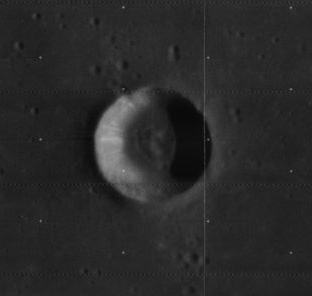
Manners is a lunar impact crater located in the western part of the Mare Tranquillitatis. Its diameter is 15 km. It was named after British astronomer Russell Henry Manners. To the northeast is the larger crater Arago and to the south are Ritter and Sabine. The crater has a rim with a higher albedo than the surrounding mare, making it appear bright. This is a circular, bowl-shaped feature with a raised rim and a relatively flat interior.

Plato is a lava-filled lunar impact crater on the Moon. Its diameter is 101 km. It was named after ancient Greek philosopher Plato. It is located on the northeastern shore of the Mare Imbrium, at the western extremity of the Montes Alpes mountain range. In the mare to the south are several rises collectively named the Montes Teneriffe. To the north lies the wide stretch of the Mare Frigoris. East of the crater, among the Montes Alpes, are several rilles collectively named the Rimae Plato.
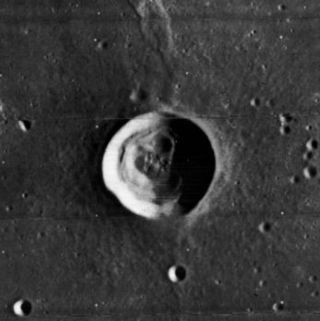
C. Herschel is a small lunar impact crater that lies on the western part of Mare Imbrium. It is named after German astronomer Caroline Herschel. It is a circular, bowl-shaped formation that has not undergone significant erosion. The interior floor has the same low albedo as the surrounding lunar mare. To the south-southwest is the similar crater Heis. C. Herschel lies on a wrinkle ridge of the lunar mare named the Dorsum Heim.

Halley is a lunar impact crater that is intruding into the southern wall of the walled plain Hipparchus. Its diameter is 35 km. The crater is named after the English astronomer Edmond Halley. On the 1645 map by Michael van Langren, the crater is called Gansii, for the gansa of Francis Godwin's The Man in the Moone. To the southwest of Halley is the large crater Albategnius, and due east lies the slightly smaller Hind.

Dionysius is a lunar impact crater that lies on the western edge of the Mare Tranquillitatis. It was named after Dionysius the Areopagite. To the southeast is the crater pair of Ritter and Sabine. Just to the northwest is the system of rilles designated Rimae Ritter. These clefts follow a generally northwest direction.

Julius Caesar is a lava-flooded lunar impact crater with a low, irregular, and heavily worn wall. Its diameter is 85 km. It was named after Roman statesman Julius Caesar. It is located to the west of Mare Tranquillitatis, and directly southeast of the crater Manilius on the Mare Vaporum. To the east is the rounded Sosigenes.

Sosigenes is a lunar impact crater on the west edge of Mare Tranquillitatis. Its diameter is 17 km. It was named after ancient Greek astronomer Sosigenes of Alexandria. It lies to the east of the large walled plain Julius Caesar. The crater rim has a high albedo, making it relatively bright. It has a small central rise at the midpoint of the floor.

D'Arrest is a lunar impact crater that is located in the lava-flooded region to the west of the Mare Tranquillitatis. It is named after the German astronomer Heinrich Louis d'Arrest. It lies to the southeast of the crater Agrippa and northwest of Delambre. Just to the northeast are the small, bowl-shaped craters De Morgan and Cayley.

Schmidt is a small lunar impact crater that is located near the southwest edge of Mare Tranquillitatis, to the southwest of the Ritter–Sabine crater pair. It was named after German astronomer Johann Friedrich Julius Schmidt, German optician Bernhard Schmidt and Soviet astronomer Otto Schmidt. This formation is circular and bowl-shaped, with little appearance of wear due to subsequent impacts. The interior has a higher albedo than the surrounding terrain, giving it a light appearance. The exterior consists of hummocky terrain with many boulders, ranging up to 100 m or more in diameter.

Lyell is a lunar impact crater that lies along the eastern edge of the Mare Tranquillitatis, at the northern arm of the bay designated Sinus Concordiae. It was named after Scottish geologist Charles Lyell. To the north along the edge of the lunar mare is the crater Franz. The region of terrain to the east of Lyell is named Palus Somni.

Whewell is a lunar impact crater that lies on a stretch of lava-resurfaced terrain to the west of Mare Tranquillitatis. Its diameter is 13 km. It was named after the 19th-century English philosopher and naturalist, William Whewell. It is located to the east of the disintegrated crater Tempel and north-northwest of D'Arrest. To the east is Cayley, a slightly larger but very similar formation. To the North lies the Rima Ariadaeus, which is a linear rille that is 300 kilometers long and was formed when a section of the Moon's crust sank down between two parallel fault lines, producing a graben. Further north again, lies the 90 km wide crater Julius Caesar.
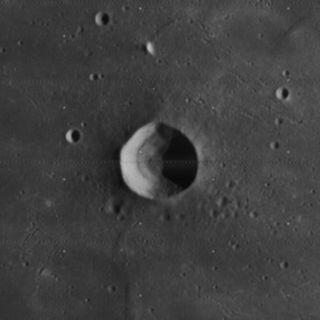
Kirch is a small lunar impact crater in the eastern part of the Mare Imbrium, a large lunar mare in the northwest quadrant of the Moon. It was named after German astronomer Gottfried Kirch. This is a relatively solitary formation with the nearest comparable crater being Piazzi Smyth to the northeast. Notable features in the vicinity are the Montes Spitzbergen mountains to the south and the solitary peak Mons Piton to the east-northeast. Kirch is circular and bowl-shaped, with a dark interior having the same albedo as the surrounding terrain.
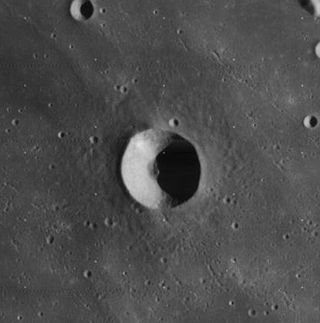
Piazzi Smyth is a small lunar impact crater in the eastern part of the Mare Imbrium. It was named after Scottish astronomer Charles Piazzi Smyth. This is an isolated feature located about 100 kilometers to the southwest of the Montes Alpes mountain range. To the southeast of this crater is Mons Piton, an isolated mountain that rises to a height of 2.3 km and occupies a diameter of about 25 km.
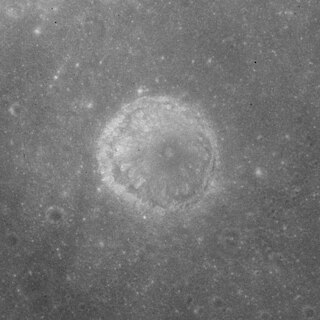
Theophrastus is a small lunar impact crater at the southern part of the Sinus Amoris, a bay at the northeast part of the Mare Tranquillitatis. It was named after ancient Greek philosopher Theophrastus. It lies to the southeast of the lava-flooded crater Maraldi, and was designated Maraldi M until the IAU gave it its current name. Just to the southeast of Theophrastus is the flooded Franz.
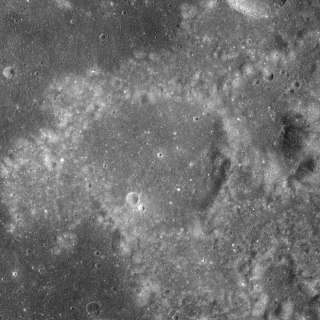
File: Franz is a small lunar impact crater identified during the Apollo mission in August 1971 and located along the eastern edge of the Sinus Amoris, a bay that forms a northern extension to the Mare Tranquillitatis. Its diameter is 25 km. It was named after German astronomer Julius Heinrich Franz. It lies to the southwest of the prominent crater Macrobius. To the north is the smaller Carmichael, and to the northwest is the diminutive Theophrastus.






















